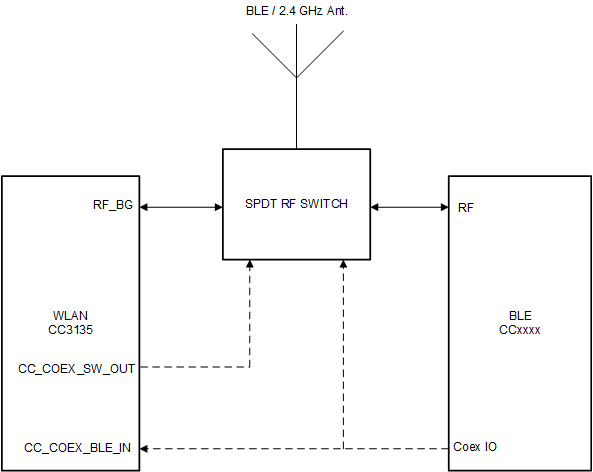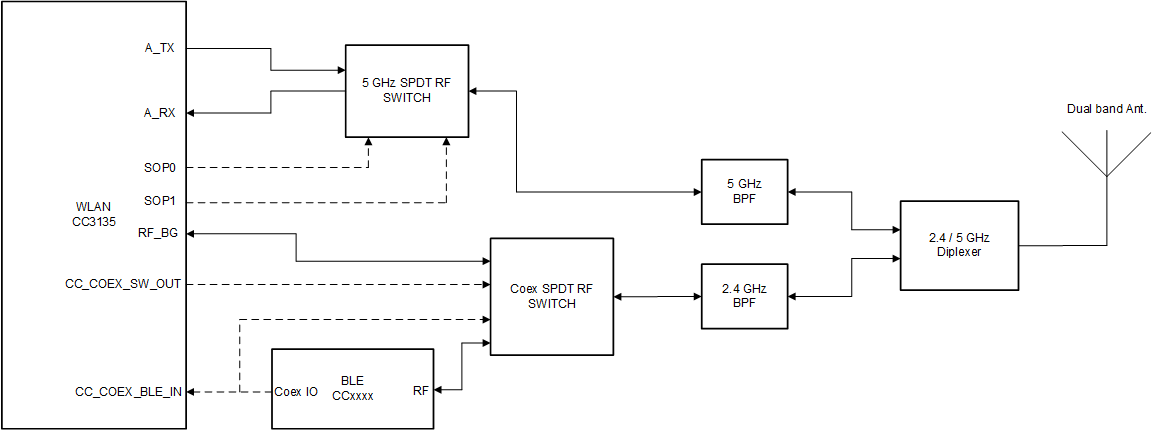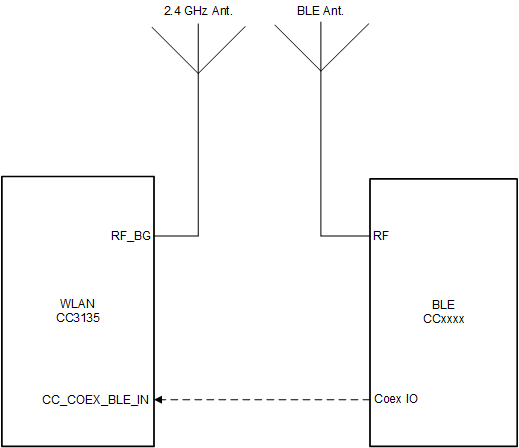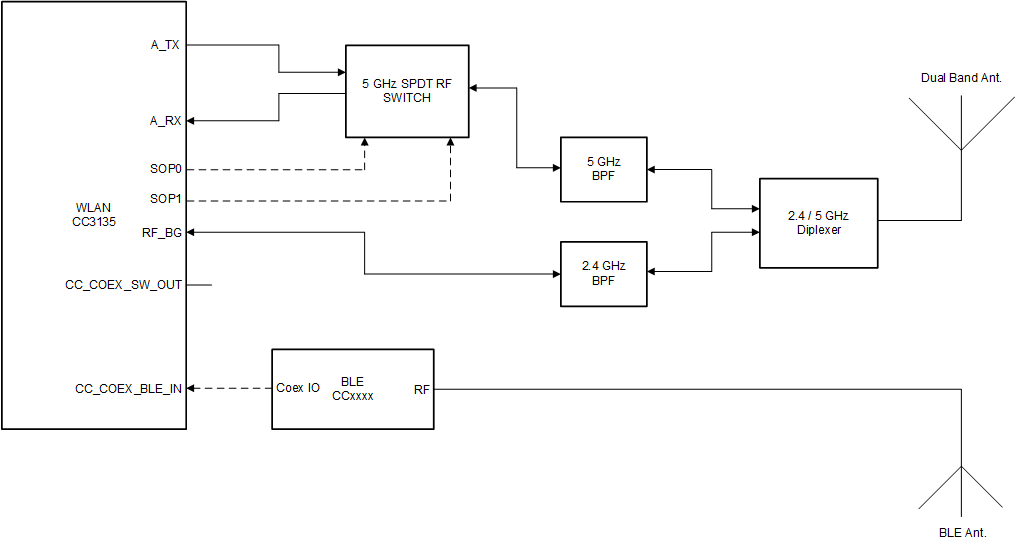SWAS037B February 2019 – May 2021 CC3135
PRODUCTION DATA
- 1 Features
- 2 Applications
- 3 Description
- 4 Functional Block Diagram
- 5 Revision History
- 6 Device Comparison
- 7 Terminal Configuration and Functions
-
8 Specifications
- 8.1 Absolute Maximum Ratings
- 8.2 ESD Ratings
- 8.3 Power-On Hours (POH)
- 8.4 Recommended Operating Conditions
- 8.5 Current Consumption Summary: 2.4 GHz RF Band
- 8.6 Current Consumption Summary: 5 GHz RF Band
- 8.7 TX Power Control for 2.4 GHz Band
- 8.8 TX Power Control for 5 GHz
- 8.9 Brownout and Blackout Conditions
- 8.10 Electrical Characteristics for DIO Pins
- 8.11 Electrical Characteristics for Pin Internal Pullup and Pulldown
- 8.12 WLAN Receiver Characteristics
- 8.13 WLAN Transmitter Characteristics
- 8.14 WLAN Transmitter Out-of-Band Emissions
- 8.15 BLE/2.4 GHz Radio Coexistence and WLAN Coexistence Requirements
- 8.16 Thermal Resistance Characteristics for RGK Package
- 8.17 Timing and Switching Characteristics
- 8.18 External Interfaces
- 9 Detailed Description
- 10Applications, Implementation, and Layout
- 11Device and Documentation Support
- 12Mechanical, Packaging, and Orderable Information
Package Options
Mechanical Data (Package|Pins)
- RGK|64
Thermal pad, mechanical data (Package|Pins)
- RGK|64
Orderable Information
10.1.1 BLE/2.4 GHz Radio Coexistence
The CC3135 device is designed to support BLE/2.4 GHz radio coexistence. Because WLAN is inherently more tolerant to time-domain disturbances, the coexistence mechanism gives priority to the Bluetooth® low energy entity over the WLAN. Bluetooth® low energy operates in the 2.4 GHz band, therefore the coexistence mechanism does not affect the 5 GHz band. The CC3135 device can operate normally on the 5 GHz band, while the Bluetooth® low energy works on the 2.4 GHz band without mutual interference.
The following coexistence modes can be configured by the user:
- Off mode or intrinsic mode
- No BLE/2.4 GHz radio coexistence, or no synchronization between WLAN and Bluetooth® low energy—in case Bluetooth® low energy exists in this mode, collisions can randomly occur.
- Time Division Multiplexing (TDM, Single Antenna)
- 2.4 GHz Wi-Fi band (see Figure 10-1)
In this mode, the two entities share the antenna through an RF switch using two GPIOs (one input and one output from the WLAN perspective).
- 5 GHz Wi-Fi band (see Figure 10-2)
In this mode, the WLAN operates on the 5 GHz band and Bluetooth® low energy operates on the 2.4 GHz band. A 2.4- or 5 GHz diplexer is required for sharing the single antenna.
- 2.4 GHz Wi-Fi band (see Figure 10-1)
- Time Division Multiplexing (TDM, Dual Antenna)
- 2.4 GHz Wi-Fi Band (see Figure 10-3)
In this mode, the two entities have separate antennas. No RF switch is required and only a single GPIO (one input from the WLAN perspective).
- 5 GHz Wi-Fi band (see Figure 10-4)
In this mode, the WLAN operates on the 5 GHz band and Bluetooth® low energy operates on the 2.4 GHz band. No diplexer is required for the dual-antenna solution.
- 2.4 GHz Wi-Fi Band (see Figure 10-3)
 Figure 10-1 2.4 GHz, Single-Antenna Coexistence Mode Block Diagram
Figure 10-1 2.4 GHz, Single-Antenna Coexistence Mode Block Diagram
Figure 10-2 shows the single antenna implementation of a complete Bluetooth® low energy and WLAN coexistence network with the WLAN operating on either a 2.4- or a 5 GHz band. The SOP lines control the 5 GHz switch. The Coex switch is controlled by a GPIO signal from the BLE device and a GPIO signal from the CC3135 device.
 Figure 10-2 Single Antenna Coexistence Solution with 5 GHz Wi-Fi®
Figure 10-2 Single Antenna Coexistence Solution with 5 GHz Wi-Fi®Figure 10-3 shows the dual antenna implementation of a complete Bluetooth® low energy and WLAN coexistence network with the WLAN operating on either a 2.4- or a 5 GHz band. Note in this implementation no Coex switch is required and only a single GPIO from the BLE device to the CC3135 device is required.
 Figure 10-3 Dual-Antenna Coexistence Mode Block Diagram
Figure 10-3 Dual-Antenna Coexistence Mode Block DiagramFigure 10-4 shows the dual antenna implementation of a complete Bluetooth® low energy and WLAN coexistence network with the WLAN operating on either a 2.4- or a 5 GHz band. In this case, the 2.4 GHz and 5 GHz Wi-Fi share an antenna and the BLE has it's own dedicated antenna. The SOP lines control the 5 GHz switch. Note in this implementation no Coex switch is required and only a single GPIO from the BLE device to the CC3135 device is required.
 Figure 10-4 Dual Antenna Coexistence Solution with 5 GHz Wi-Fi®
Figure 10-4 Dual Antenna Coexistence Solution with 5 GHz Wi-Fi®